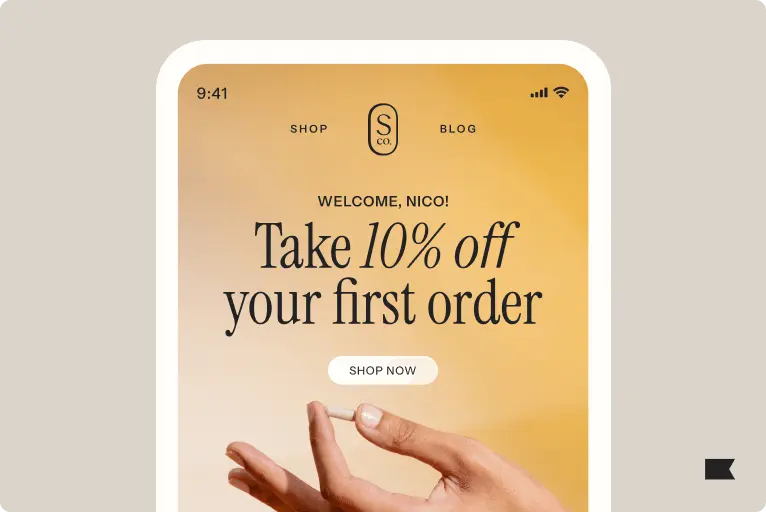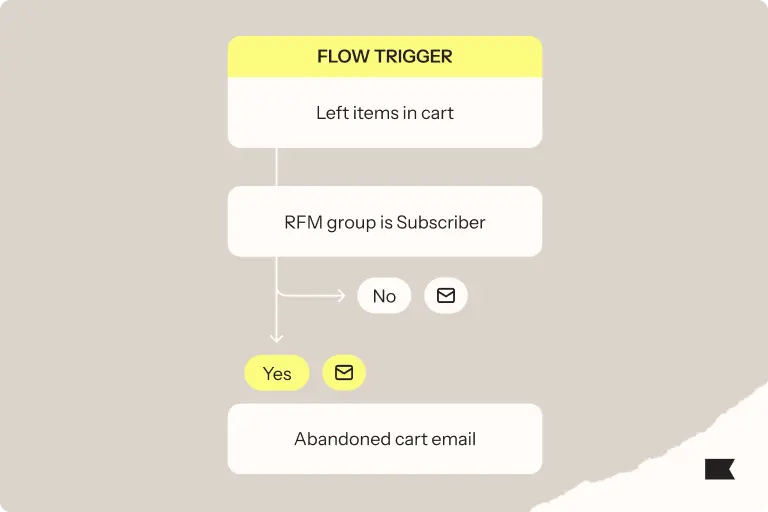8 benefits of email marketing for ecommerce brands in 2024
In our world of catchy social media posts and affiliate marketing, email might seem to take a back seat.
But don’t be fooled. Email delivers powerful ROI for ecommerce brands—just as it always has.
Connie Cen, founder and owner of Rocketeer Media, says healthy ecommerce brands drive at least 20–40% of their revenue through email marketing.
And according to Klaviyo’s marketing mix report, 76.86% of ecommerce businesses place email marketing in the top 3 ROI-generating marketing channels.
Ecommerce email marketing—the practice of emailing customers to boost product sales and brand engagement—offers your business several benefits.
Here are 8 benefits of email marketing that prove you should not only take it seriously, but also devote serious time to leveraging this channel.
1. Email marketing generates steady, reliable ROI
While most marketing channels can deliver high ROI, email almost certainly guarantees it. That’s because your email list subscribers are highly engaged and likely to complete actions that make you money.
We can best make this point with some numbers from Klaviyo’s 2024 benchmark report:
Email campaigns
- Open rates average 39.74% and reach 56.32% for the top 10% of brands
- Click rates average 1.47% and reach 5.06% for the top 10% of brands
- Placed order rates average 0.09% and reach .47% for the top 10% of brands
Email automations, or flows
- Open rates for all flows average 52.04% and reach 68.08% for the top 10% of brands
- Click rates for all flows average 5.31% and reach 12.98% for the top 10% of brands
- Revenue per recipient (RPR) averages $1.94 for all flows and reaches $16.96 for the top 10% of brands
- RPR climbs even higher for the welcome flow ($2.65 average; $21.18 top 10%) and abandoned cart flow ($3.65 average; $28.89 top 10%)
The story here is simple. Email marketing is “really reliable revenue if you work it right,” says Ari Murray, chief growth officer at Sharma Brands and founder of the ecommerce newsletter Go-to-Millions. “It’s such an inexpensive way to talk to your customers.”
2. Email marketing gives you more control
Email and SMS lists are the only things on the internet you truly own. Everything else, you’re temporarily renting.
That became obvious in 2021, when Apple’s 2021 iOS 14.5 update built a walled garden around iOS users, significantly reducing targeting and attribution capabilities on paid social media. Now, social media platforms give you exposure to your audience, but you’re at the mercy of their algorithms.
Email is very much in your control because it’s an owned channel.
Murray puts it simply: “Email is very much in your control because it’s an owned channel.” And in a privacy-first world, “owned channels are of the utmost importance.”
With email marketing, you can build strong relationships, boost sales, increase brand awareness, or do it all at once. After all, it’s your list.
3. Email marketing generates quick, measurable results
Since email is an owned channel, that control you gain becomes immensely beneficial when it’s time to measure the performance of your email campaigns and adjust your strategy based on the results.
Engagement—and lack thereof—gives you important information about how valuable your subscribers find your emails. Understanding which specific CTA button, image, or section of your email someone clicked after opening gives you even more in-depth insight into what resonates.
But what should you do with all that owned data? Test it, of course.
It’s easy to A/B test different versions of emails to measure and improve effectiveness. Quickly test the best send time, whether to use emojis in your subject lines, which CTAs are irresistible to readers, and more.
Since testing outcomes is straightforward with email marketing, you can avoid bias and make fast updates based on the findings—a significant advantage of using the channel.
4. Personalized messaging is easy with email marketing
Companies that excel at personalization in marketing generate 40% more revenue from related activities than average players, according to McKinsey & Company. McKinsey also reports that while 71% of consumers expect personalization from the brands they interact with, even more (76%) get frustrated when they don’t get it.
Email segmentation is what helps you personalize messaging to customers and prospects within your funnel once you’ve gathered data about their preferences based on behavioral triggers, purchase history, and engagement rates.
The Willow Tree Boutique, for example, uses email marketing to promote luxury items to bigger spenders. The boutique sends campaigns highlighting pricey apparel to segments with demonstrated spending power—customers with a predicted CLV over $500, or an average order value over $150.
Smart email segmentation is just one factor that contributed to a 44.6% YoY increase in Klaviyo-attributed revenue.
5. Email marketing reaches customers at every buying stage
Jen Wallace, director of digital marketing at full-service digital experience agency Northern Commerce, believes email and SMS, as owned marketing channels, “represent customer lifetime value”—largely because they let you target every stage of the customer lifecycle.
While some people are ready to buy immediately, others need more time to decide. Email marketing helps you identify the latter, offer them helpful content and product recommendations, and eventually turn them into customers.
“Oftentimes, people get into a mindset of acquisition and making sure your funnel is full, so they’re focused on new customers or first-time purchasers,” Wallace says. But when it comes to developing repeat customers and customer lifetime value, “email is very hard to beat.”
Once you shift your marketing focus to retention, typically you start to see that your customer acquisition budget doesn’t have to work so hard.
A smart email marketing strategy nurtures the post-purchase customer relationship by continually engaging people who’ve opted in to stay connected to your brand, which makes it a prime channel for boosting customer retention in the long run.
“Once you’ve captured that customer, email marketing can really help to make the rest of your funnel start to look a whole lot healthier,” Murray explains.
“And once you shift your marketing focus to retention,” Wallace says, “typically you start to see that your customer acquisition budget doesn’t have to work so hard.”
6. Email marketing reduces data privacy issues
Modern consumers are sensitive to data abuse, as reactions to unsolicited communication and data privacy violations attest. That means your marketing efforts need to revolve around consent.
Email marketing incorporates consent from the beginning, reducing fears of privacy violations. People join your list because they want you to communicate with them, which guarantees a baseline level of engagement.
While you must still craft the right messages and deliver value, the very fact that you’re welcome in a personal space (the consumer’s inbox) is a huge benefit of email marketing—and it’s associated with high engagement, sales, and brand recall.
7. Save time: another advantage of email marketing
One of the biggest benefits of email marketing is the time it saves you. Thanks to email automation, crafting personalized emails and delivering critical information to your audience segments is fast.
You can quickly target almost every consumer action to boost your chances of a sale. Here are some examples of email automations you can execute with a few clicks:
- Welcome series: Introduce your brand to new email subscribers and share information about your mission and products.
- Cart abandonment flow: Remind shoppers when they leave items in their cart. Set up triggers to offer time-based discounts or bonuses to incentivize a purchase.
- Cross-sell flow: Personalize emails with product recommendations based on past purchases.
- Post-purchase follow-up: Thank customers for their purchase and share educational resources, such as lookbooks or maintenance instructions.
- Win-back flow: Target people who have stopped purchasing from you. Seek feedback and offer special access to sales to re-engage them.
- Loyalty rewards: Offer loyal customers exclusive access and make them feel special, or remind them they have loyalty points to spend on a future purchase.
8. Stay top of mind among your target audience
As an ecommerce marketer, you want consumers to think of you when they have a need. The question is, how can you stand out in a crowded field of competing ecommerce brands? Email marketing is one of the best ways of achieving this goal for a few reasons:
- You have access to a consumer’s personal space (their inbox).
- Consumers have willingly given you this access by subscribing to your list.
- They’re less likely to ignore messages in this personal space.
- You have tools and data to personalize content for your subscribers.
- You can easily deliver tailored offers that incentivize purchases.
Emails are also a great way to deliver messages that do not have commercial intent. For instance, you can use email to build awareness about your community support programs or provide product updates.
The result is more presence in your audience’s minds and higher odds that they’ll think of you when a buying need arises.
Email marketing delivers—and it’s time you joined the party
As the numbers prove, the advantages of email marketing add up.
“I understand that the major thing email marketing really helps with is getting worry off your plate,” Cen says. “Whether it’s revenue, retention, customer experience, customer engagement—all of those can be solved with email marketing.”



